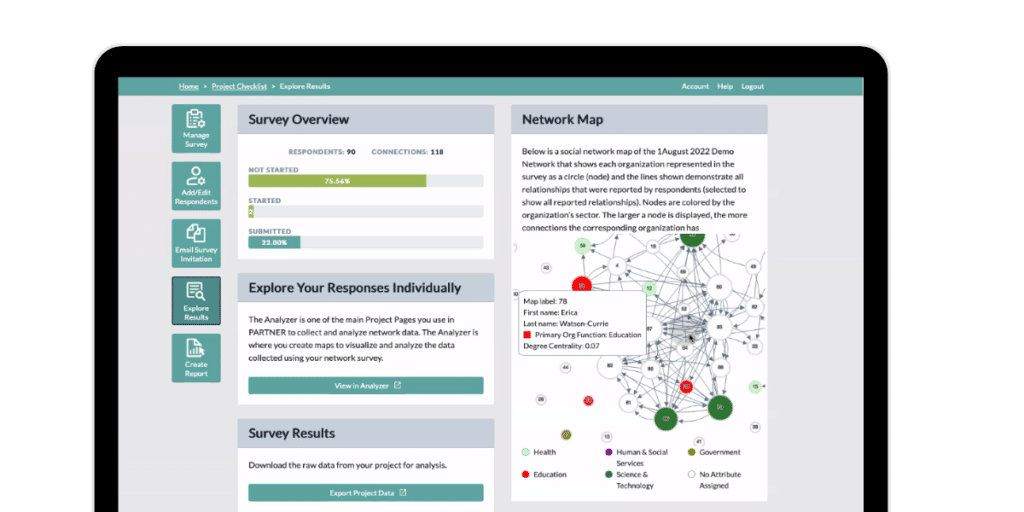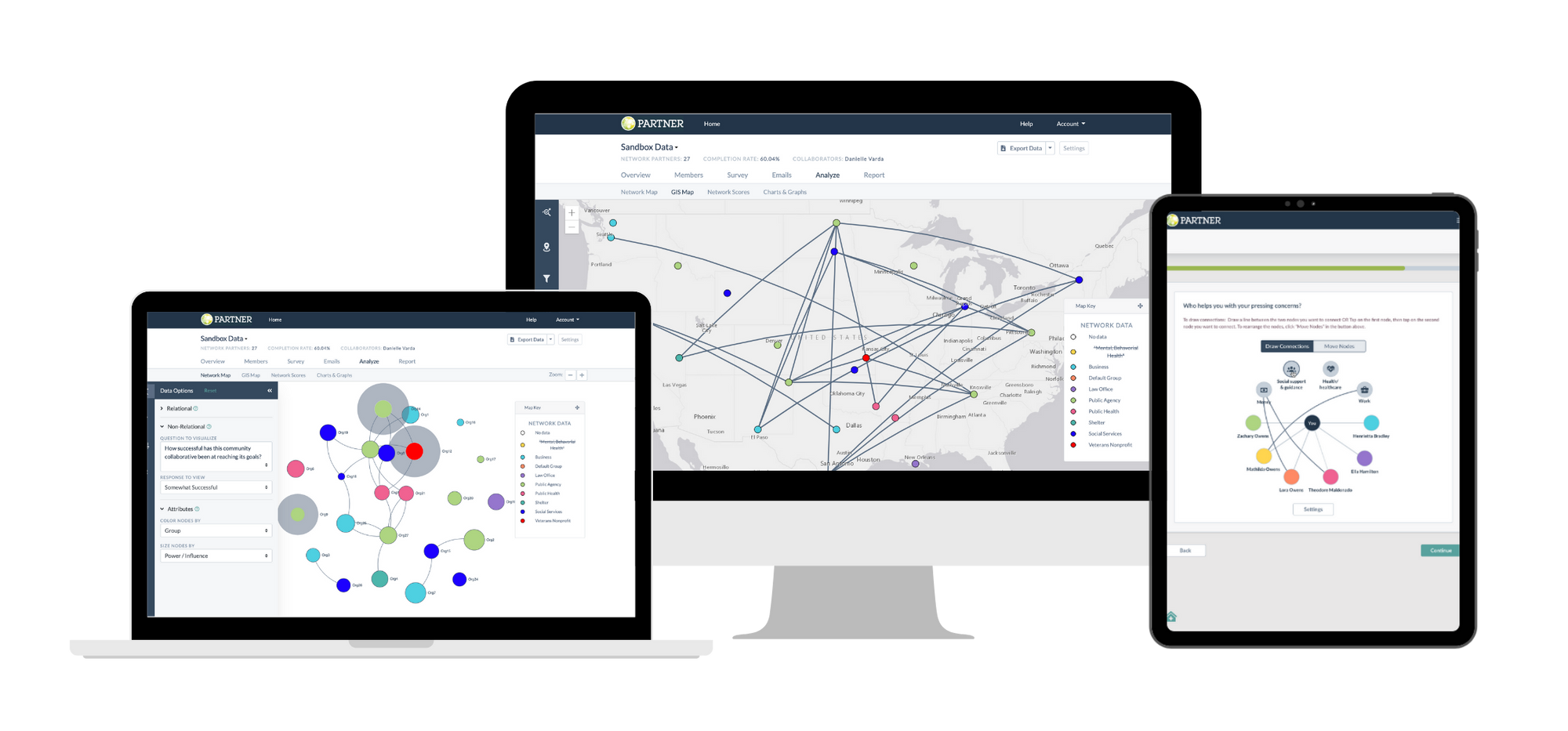
Ecosystem Mapping and Tracking for Community Health: Research Articles and Resources
During our webinar last week on Ecosystem Mapping and Tracking for Community Health, we shared a number of research articles and resources for those who want to learn more about the subject. We asked our team for more of their favorite links and compiled them below for you to share and explore. If you have any suggested articles we should add, make sure you leave a comment with your recommendations below with our community.
10 Network & Ecosystem Research Articles Related to Community Health
1. Using Network Analysis to Understand Community-Based Programs: A Case Study From Highland Madagascar
Kirsten Stoebenau, Thomas W. Valente
This early research article demonstrates how social network analysis can improve the understanding of community-based program functioning by providing a way to examine who receives information from and is influenced by CBD agents. Click here to read the paper.
2. Putting the Network in Network Interventions for Community Health Improvement
Thomas W. Valente
This study highlights the potential effectiveness of network theory and data in implementing health-promoting interventions. Although the study has focused on selecting influential nodes, other tactics like respondent-driven sampling, network segmentation, and network outreach have proven effective in certain settings. To advance the field, future developments should compare different network intervention approaches and align behavioral and epidemiological theory with intervention choice. Click here to read the paper.
3. Collaboration and Competition in a Children's Health Initiative Coalition: A Network Analysis
Thomas W. Valente, Kathryn A. Coronges, Gregory D. Stevens, Michael R. Cousineau
This case study analyzes inter-organizational networks among members of a coalition created to expand health insurance coverage to uninsured children in a large metropolitan area. Six networks were measured: collaboration, competition, formal agreements, receive funding from, send funding to, and greater communication. The study suggests that perceptions of organizational performance are associated with position in the network, central members are more likely to perceive the organization performs well than those on the periphery. Click here to read the paper.
4. Analysis of Network Characteristics and Quality of Interactions Among Public Health Collaboratives
Danielle M. Varda, Jessica H. Retrum
While the benefits of collaboration have become widely accepted and the practice of collaboration is growing within the public health system, a paucity of research exists that examines factors and mechanisms related to effective collaboration between public health and their partner organizations. The purpose of this paper is to address this gap by exploring the structural and organizational characteristics of public health collaboratives. Click here to read the paper.
5. Implications of Network Structure on Public Health Collaboratives
Jessica H. Retrum, Carrie L. Chapman, Danielle M. Varda
Very little comparative research exists on how public health partnerships develop and evolve, specifically in terms of how subsequent network structures are linked to outcomes. A systems science approach, that is, one that considers the interdependencies and nested features of networks, provides the appropriate methods to examine the complex nature of these networks. Applying Mays and Scutchfields’s categorization of “structural signatures” (breadth, density, and centralization), this research examines how network structure influences the outcomes of public health collaboratives. Click here to read the paper.
6. Core Dimensions of Connectivity in Public Health Collaboratives
Danielle M. Varda, Anita Chandra, Stefanie A. Stern, and Nicole Lurie
In this article, we use network theory and social network analysis to outline the core dimensions of connectivity used to measure progress in public health collaboratives. Connectivity is defined as the measured interactions between partners in a collaborative such as the amount and quality of interactions and how these relationships might change over time. We also articulate how these measures fit into the overall process of measuring progress in public health collaboratives and end the article with suggestions for future research and development. Click here to read the paper.
7. Data-Driven Management Strategies in Public Health Collaboratives
Danielle M. Varda
Data-driven strategic approaches to practical decision-making and program implementation are currently lacking in public health systems improvement. Leveraging a network or systems-based approach leads to QI strategies, gives health departments a plan of action to meet accreditation standards, and contributes to the field in terms of improved measurement and assessment techniques. Click here to read the paper.
8. Insights Into Collaborative Networks Of Nonprofit, Private, And Public Organizations That Address Complex Health Issues
Danielle M. Varda, and Rachel Hogg
Despite the increases in the numbers of and funding for cross-sector networks, and the growing literature about them, there are limited data and methods that can be used to assess their effectiveness and analyze their designs. We addressed this gap in knowledge by analyzing the characteristics of 260 cross-sector community health networks that collectively consisted of 7,816 organizations during the period 2008–15. We found that nonprofit organizations were more prevalent than private firms or government agencies in these networks. Traditional types of partners in community health networks such as hospitals, community health centers, and public health agencies were the most trusted and valued by other members of their networks. However, nontraditional partners, such as employer or business groups and colleges or universities, reported contributing relatively high numbers of resources to their networks. Click here to read the paper.
9. Preventable Death Rates Fell Where Communities Expanded Population Health Activities Through Multisector Networks
Glen P. Mays, Cezar B. Mamaril, and Lava R. Timsina
The US health system faces mounting pressure to improve population health. Research suggests a need for greater coordination and alignment across the sectors that deliver medical, public health, and social services. This study uses sixteen years of data from a large cohort of US communities to measure the extent and nature of multisector contributions to population health activities and how these contributions affect community mortality rates. The results show that deaths due to cardiovascular disease, diabetes, and influenza decline significantly over time among communities that expand multisector networks supporting population health activities. Click here to read more.
10. Advancing the Science of Delivery: Public Health Services and Systems Research
Mays, Glen P., Scutchfield, F. Douglas
The article discusses the evolution of public health services and systems research (PHSSR) in the last ten years. PHSSR is an emerging field of applied research that focuses on finding better ways of delivering public health services in real-world community settings. The article describes how the field has expanded and gained more attention in scientific and professional communities, with increased funding, the establishment of practice-based research networks, and the creation of national coordinating centers. The article also highlights the challenges and opportunities that PHSSR faces, including fiscal pressures, voluntary accreditation programs, and the implementation of healthcare reform. To ensure the relevance and practical application of PHSSR, the article emphasizes the importance of conducting research in real-world settings and developing a shared national research agenda. Click here to read more.

Make it All Happen with PARTNER CPRM
Building trust, balancing breadth, managing shared resources, evaluating progress, learning, and adapting… how does one do it all? The first step is to centralize how you collect, manage, and share your collaborative partner data so you can begin tracking your progress and creating evidence-based strategies to improve.
PARTNER CPRM is our community partner relationship management platform, designed for this specific use case. You can use it to visualize your collaborative structure and quality, demonstrate your impact and link processes with outcomes, and create a data-driven collaborative strategy for the future. Our team is here to help with onboarding, design, implementation, and capacity-building to make the most of your experience.
Click here to learn more about PARTNER CPRM.





